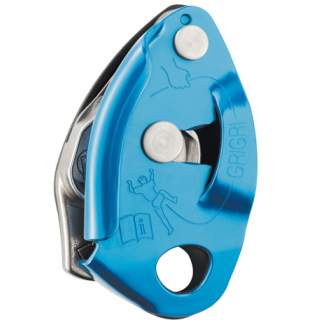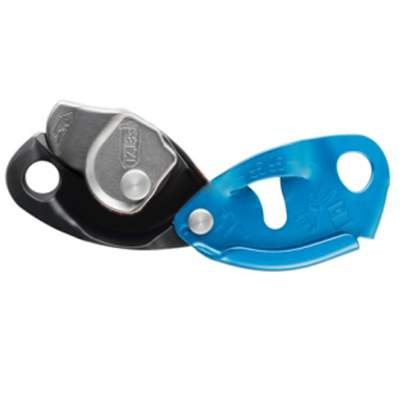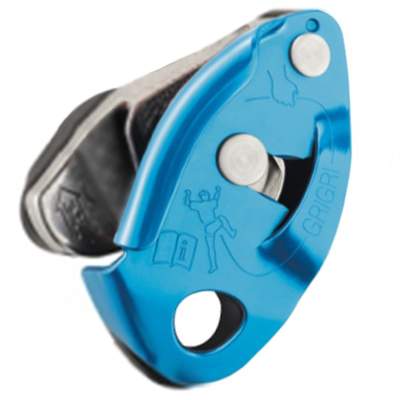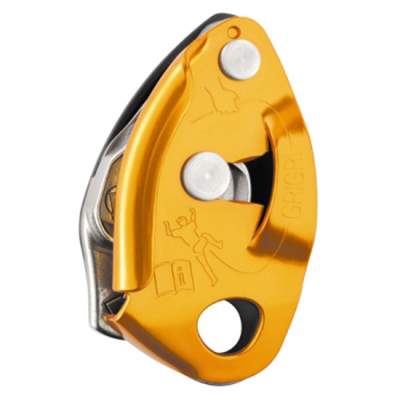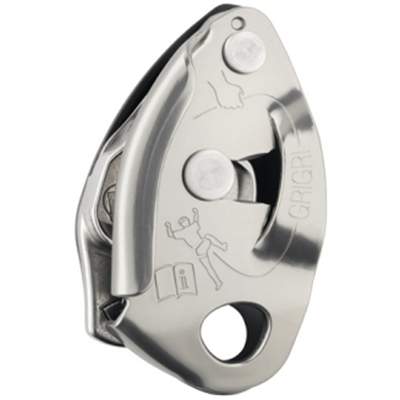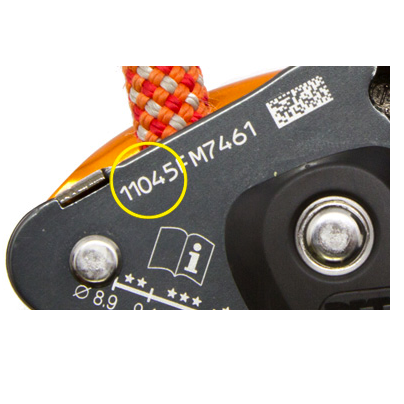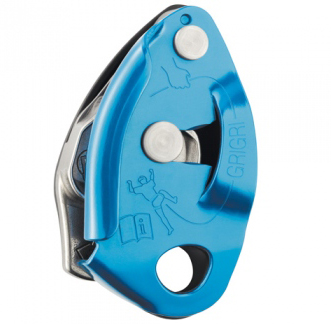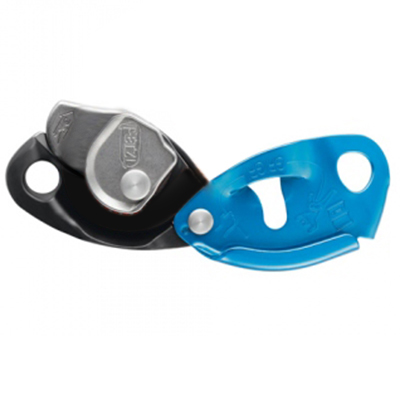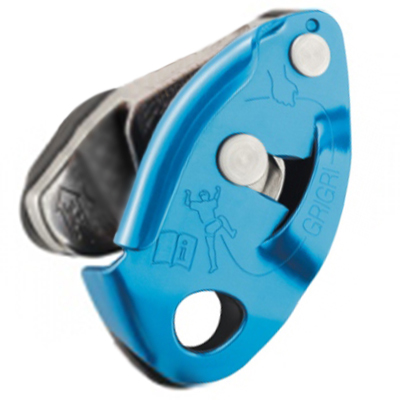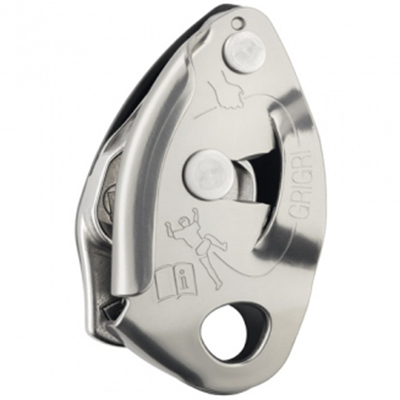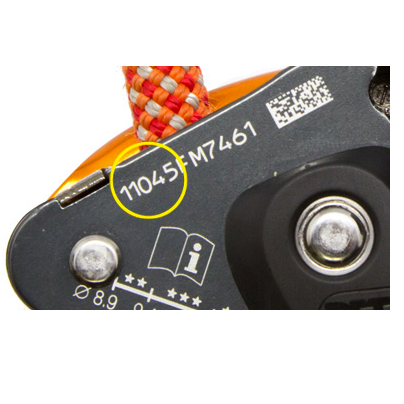GriGri 2
Description
The GRIGRI 2 belay device with assisted braking is designed to facilitate belay maneuvers. The GRIGRI 2 works equally well for lead climbing and top roping. It may be used on all single dynamic 8.9 to 11 mm ropes on the market (ideal at 9.4 mm to 10.3 mm). Both compact and ultra-light, the GRIGRI 2 will accompany you on climbs around the world for many years. The GRIGRI 2 has a new design that allows excellent control during the descent.
-Belay technique identical to classic belay systems: both hands on the rope. A fall is stopped by tightening the hand on the free end of the rope.
-Assisted braking capability: during fall arrest, the belayer holds the free end of the rope, the cam pivots and pinches the rope, increasing the braking action until the rope stops sliding.
-The GRIGRI 2 has a new design that allows excellent control during the descent. One hand holds the rope and the other uses the handle to unlock the cam. The patented handle design allows a very gradual release of the rope. In combination with the strong braking action of the cam, it gives a great feeling of control when lowering a partner or rappelling.
-The GRIGRI 2 is compact and ultra-light at 185 g (25 % smaller and 20 % lighter than the GRIGRI)
-The construction includes a stainless steel friction plate and cam to ensure a long life for the product
-For 8.9 to 11 mm single ropes (ideal at 9.4 to 10.3 mm)
-Diagrams for rope installation engraved on belay device (interior and exterior)
Retail price
This Product is Hard to Find.
We don’t know where you can buy this item online in the US. We’ll continue to check all the major retailers and will update this page as soon as we find one.
If you know where to find this online in the US, let us know, and we’ll add the link.


Device Type  Device TypeTubeThe most commonly used belay type also called an “ATC” or “tuber.” Other than a distinction between other belay device types, “Tube” is a rarely used term, most climbers just assume you're talking about this style when they refer to your "belay device." 
Figure 8Mostly used in rescue, canyoneering, tactical, work safety, or by old school climbers and rappellers. One reason they went out of popularity with recreational climbers is because they tend to create twists in the rope. 
Brake AssistThese devices assist in stopping the rope when a climber falls or hangs on the rope. 
Often referred to as “auto-blocking” but that’s not the official terminology because no belay device should be assumed to work automatically by itself, even if it feels like it does (or does most the time). PlateWhen simplicity is a must, or you started climbing before Tubers were the norm. Bonus: They tend to be very light weight. 
DescenderFor rappelling, not for belaying a lead climber or top-roping. 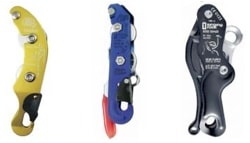 |
Brake Assist - Mechanical |
Weight (g)  Weight (g)In grams, the weight, as stated by the manufacturer/brand. |
185 g |
Belay Brake Assist  Belay Brake AssistThis is when the belay device significantly reduces the amount of holding power the belayer must exert to stop a fall and hold a climber. This is also called "assisted-braking" as the device must hold a significant amount of the climber’s weight; this term does not include friction-adding "teeth" found on some tube style belay devices. Confusingly referred to as “auto-blocking” or “auto-locking” these terms wrongly imply the device will always, automatically, stop a fall or hold a climber even if the belayer/rappeller is hands-free. These devices are not meant to be used without a hand on the braking side of the rope; the belayers/rapppeller brake hand should always be on the brake rope. Worth ConsideringMost of the mechanical brake assist devices only hold a single strand of rope and are not capable of double-strand rappelling (the most common method of rappel). |
Yes |
| Rope Options | 1 rope only |
Guide Mode  Guide ModeThis is when you belay directly off the anchor instead of your harness. Guide mode is helpful if you climb outdoors a lot because it reduces the holding power required from the belayer. When your partner falls or rests, the weight of the climber is held mostly by the anchor and the belay device. Tubers and PlatesWhen belaying in "guide mode," the tubers and plates turn auto-blocking. During a fall, the climbing rope pinches the slack rope, completely stopping the movement of either rope. A common guide mode setup shown below. 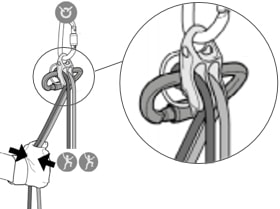
Mechanical Brake Assist DevicesThere is no difference in the functionality of the device. A brake-hand should always be on the rope to ensure the climber is caught in the case of a fall. A common guide mode setup shown below. 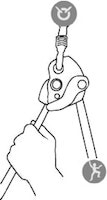
Where guide mode is used
Learn Morehttp://www.climbing.com/skill/essential-skills-auto-blocking-belay-devices/ |
1 follower only |
Teeth  TeethTeeth are only seen on tube devices. They add friction that helps grip the rope for more belaying control. This is helpful for belaying heavier climbers. Teeth are becoming standard on new tube devices. 
Worth ConsideringTeeth do wear out. You can limit wear by rappelling on the side without teeth (if you don’t need the extra friction). Once they’re worn, you’ll still have a usable belay device, just less friction. |
No |
Rope Range (mm)  Rope Range (mm)The range of rope diameters, in millimeters, that the manufacturer/brand specifies can safely be used. This is the best case scenario and does not necessarily take into consideration that certified ropes have a tolerance of +/- .3 mm. Recently, manufacturers have started to add an "optimized" rope range -- this is the range that will result in the nicest handling of the belay device. | 8.9 mm - 11.0 mm |
Certification  CertificationsThe main climbing gear certifications are CE and UIAA--and normally the UIAA creates the rules that the CE body also supports. When possible, we try to list all the certifications the product carries. To sell a climbing product in Europe, the device must be CE certified. There are no official requirements to sell climbing gear in the US. The UIAA certification is a voluntary process. Learn MoreRock and Ice Certifications Guide |
|
No reviews yet.
[Review written for the original GriGri]
The Petzl Grigri self-braking belay/descender device is a true industry standard. What can I say about the Grigri that has not been said over the years? Sure, some people will tell you that the Grigri does not give a dynamic belay and therefore increases forces on gear placements, blah, blah,...these are the ones still using figure-eights. However, proper use should negate this issue. I have used the Grigri to climb sport routes, long free routes and one-day ascents of El Cap; and each time, the Grigri
has facilitated our efforts. Thanks to its durability, ease of use and reliability, not to mention the diagram (for monkeys like myself), it has become for me, the most trusted belay device on the market.
While there are some folks who prefer to avoid GriGris and see them as an insult to proper climbing technique, I commend Petzl on a revolutionary design that spans the climbing world from the greenest beginner to the most experienced athlete. The GriGri2 is just another step in the right direction, building upon a legend of design. While the specific changes from the GriGri do not warrant a mandatory upgrade now, the GriGri2 will probably replace it's predecessor over time and continue to meet the tallest of climbing demands.
Pros: Best belay device ever; lighter, smaller than the first GriGri; PDC; wider range of rope diameters = 8.9mm - 11mm (instead of the older prescribed rope sizes of 10mm-11mm).
Cons: Bites more on fatter ropes; not improved enough to buy the GriGri2 before your old GriGri wears out; where's the headphone jack?
- ‹ previous
- 2 of 2
If you know of a good product video that should be here, let us know, and we'll put it up.
If you're looking for gear videos in general, check out our Vimeo and YouTube channels to see the newest gear.

